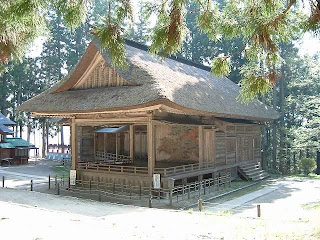Air conditioners use too much electricity, so sales of electric fans have exploded. Various items to beat the heat including folding fans, paper fans, bamboo blinds and water pillows are selling well. The green wall(green facade) is also popular. wind-bells actually don't cool a room, but they make us feel cool. So they are also selling well.
 |
| Chuson-ji Hondo(main hall) |
Hiraizumi(平泉) including Chuson-ji Temple (中尊寺) and Motsu-ji Temple (毛越寺) in Iwate Prefecture was registered as a World Heritage site by UNESCO on June 28th.
On the 13th day of the 5th month in the lunar calendar(on June 29th in the Gregorian calendar) in 1689, haiku poet Matsuo Basho(松尾芭蕉) visited Hiraizumi during the rainy season and composed the following poems.
 |
| Gikeido (Yoshitsune Hall) in Takadachi |
夏草や兵どもが夢の跡
(Na-tsu-ku-sa-ya Tsu-wa-mo-no-do-mo-ga Yu-me-no-a-to)
"A long time ago powerful warriors fought with dreams of supremacy here, but a whole field of summer grass spread out in front of me now," written by Matsuo Basho.
Basho wrote this poem at Takadachi, the deathplace of Minamoto no Yoshitsune(源義経, 1159-1189), located to in the southeast of Chuson-ji Temple.
 |
| Chuson-ji Tsukimizaka |
Yoshitsune was a tragic hero whose brother Minamoto no Yoritomo(源頼朝) was the founder of the Kamakura Shogunate. Although Yoshitsune craved affection and acceptance from his brother, Yoritomo cast off Yoshitsune. He escaped to Hiraizumi counting on the Fujiwara family because he was put under the protection of Fujiwara no Hidehira(藤原秀衡) for a period of time.
 |
| Chuson-ji |
Hidehira welcomed him, but Hidehira's son
Yasuhira (泰衡) drove Yoshitsune to his death to keep peace of Hiraizumi after Hidehira's death. However, the family was destroyed by Yoritomo in 1189 after Yoshitsune's death .
Yoshitsune was very popular in Japan, so he appears in many legends and stories such as "Yoshitsune and the Thousand Cherry Trees(義経千本桜, Yoshitsune Senbon-zakura)".
 |
| current saya-do housing Konjiki-do |
五月雨のふり残してや光堂
(Sa-mi-da-re-no Fu-ri-no-ko-shi-te-ya Hi-ka-ri-do-u)
"Surrounding buildings have fallen into decay, but only Hikari-do is as resplendent as it was ever. As if early summer rain skirted around it," written by Matsuo Basho.
 |
| Konjiki-do(Pictures prohibited in here) |
 |
| Chuson-ji Benkei-do |
Some people say "the land of gold" called jipangu in the Book of Marco Polo (1299) referred to Konjiki-do of Chuson-ji Temple that the Northan Fujiwara family built. The family took advantage of alluvial gold and horses which were specialties of Tohoku to reign over Tohoku region virtually for three generations including Kiyohira(清衡), Motohira(元衡) and Hidehira(秀衡).
 |
| Chuson-ji Noh stage |
Konjiki-do (金色堂) built in 1124 literally means "Golden Hall". The mummified remains of Kiyohira, Motohira and Hidehira and Yasuhira's head are placed in the hall. In 1950, several seeds of lotus were found in the wooden container in which Yasuhira's head was enshrined. Some of them put forth buds in 1993 and came into bloom in 1998.
 |
| former wooden saya-do |
Wooden saya-do(覆堂) housing the hall is thought to have been built in the 15th century and was moved near the hall. This saya-do is now designated as an Important Cultural Property of Japan. the Date family, the lords of the Sendai Domain supported the temple in the Edo Period. Basho saw the hall housed in this wooden saya-do.
The Japanese government has preserved the temple since the Meiji Period. In 1962, the hall was dismantled to restore.
I've been to Hiraizumi including Chuson-ji and Motsu-ji. I was impressed because I could imagine the past glory of Chuson-ji Temple from the current state of the temple, Basho's haiku poems and the tragedy of Yoshitsune. I wonder if visitors who are not emotionally attached to them will be touched by the temple.
 |
| Motsu-ji Jodo Garden |
 |
| Motsu-ji Jodo Garden |
The garden represented Sukhavati (Amitabha's Pure Land). Even in Kyoto, there are very few Jodo gardens. It is said that only Motsu-ji's garden still retains the original form of Jodo garden.
 |
| Motsu-ji Jodo Garden in autumn |
The garden differs from most gardens in Japanese temples, so it left a fresh impression on me. The garden had a relaxed atmosphere. I thought the garden appeared similar to Chinese garden.
photos by 日本列島お国自慢
列島宝物館(平泉)
No comments:
Post a Comment